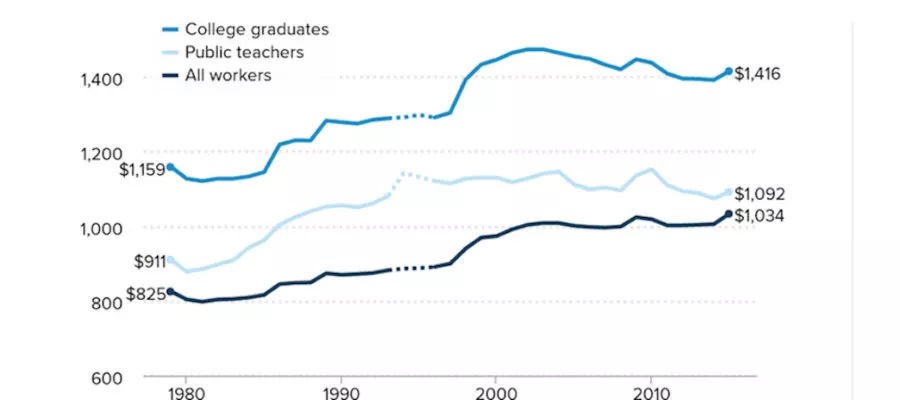Last week, the National Conference of State Legislatures (NCSL) released a report that warned in no uncertain terms that the U.S. education system was falling behind those of other nations. The study was the result of a bi-partisan working group that traveled to high-performing countries to determine what policies and practices could serve as a model back home.
Their conclusion? Much of what was succeeding in these systems could and should be replicated in the United States, including the necessary work around building a world-class teaching force. This entails more rigorous recruitment strategies, embedded professional development, career ladders for educators — and better pay:
In high-performing countries, teachers are compensated more generously than American teachers, typically earning pay similar to that of senior civil servants and professionals such as engineers and accountants. They are expected to be the best in the world and are compensated accordingly. Many nations view their teachers as “nation builders,” preparing the country’s next generation.
Educators in the United States are also expected to be the best, but are nonetheless asked to withstand a severe "teacher pay penalty" - the loss of income when choosing teaching over an alternate profession. While no one believes a career in the classroom will bring unbridled wealth, at least high-performing nations, as the NCSL study emphasizes, minimize the pay gap between their "nation builders" and other workers with similar education levels.
How teacher pay stacks up to other fields is a major factor in the decision whether to become an educator. Many parts of the country are facing crippling teacher shortages, retirements are ratcheting up, and the number of college students considering teaching as a profession is at an all-time low.
Teachers face low wages, high levels of student debt, and increasing demands on the job. Eliminating the teacher pay penalty is crucial to building the teacher workforce we need” - Lawrence Mishel, Economic Policy Institute
As Linda Darling-Hammond of Stanford University wrote in a 2016 paper:
"Even if teachers may be more motivated by altruism than some other workers, teaching must compete with other occupations for talented college and university graduates. … Teachers are more likely to quit when they work in districts with lower wages and when their salaries are low relative to alternative wage opportunities, especially in high-demand fields like math and science.”
In the bid to make a teaching a viable and attractive career option, the United States has a lot of ground to make up. The Economic Policy Institute recently analyzed the wages of educators relative to other workers and found that penalty teachers endure has become more severe.
“In order to recruit and retain talented teachers, school districts should be paying them more than their peers,” said Lawrence Mishel, co author of "The Teacher Pay Gap is Wider Than Ever." “Instead, teachers face low wages, high levels of student debt, and increasing demands on the job. Eliminating the teacher pay penalty is crucial to building the teacher workforce we need.”
 According to EPI's analysis, in 1994, educators earned 1.8 % less than similarly-trained workers in other fields. By 2015, that gap has widened to 17%. Since 1996, teacher pay has decreased $30 per week, while for others, average weekly wages have increased more than $100 - from $1,292 to $1,416 in 2015.
According to EPI's analysis, in 1994, educators earned 1.8 % less than similarly-trained workers in other fields. By 2015, that gap has widened to 17%. Since 1996, teacher pay has decreased $30 per week, while for others, average weekly wages have increased more than $100 - from $1,292 to $1,416 in 2015.
The gap remains stubbornly large even if you factor in some of the benefits many educators have that may not be available to other college-educated workers. Including benefits, teachers are still far behind with an -11.1% compensation gap.
Focusing on gender, the data reveals that the wage gap for male teachers has consistently been larger over time. The male teacher wage gap was -22% in the late 1970s, but narrowed to around -15% in the mid-1990s. Over the next two decades, the gap grew sharply, standing at -24.5% in 2015.
By contrast, female teachers have seen their pay advantage over comparable female workers disappear completely over the past six decades. In 1960, female educators earned 14.7% more in weekly wages, but by 2015, the teacher penalty for women -- a -13.9% gap -- was deeply-rooted.
According to EPI's analysis, however, these discrepancies fade if the teacher benefits from collective bargaining. The wage gap is up to 6 percentage points less than teachers who are nonunion. For female educators, the improvement is more pronounced. Over 1996–2015, the pay gap of female teachers with collective bargaining was 7.5 percent, less than half the 18.8 percent penalty experienced by female teachers working without those agreements.
“Once again, unions prove their importance in protecting teachers from a much larger pay gap,” said co-author Sylvia A. Allegretto. “For women, especially, being a member of a teacher’s union can have a major impact on earnings.”
The EPI report cautions that discussion around the teacher pay penalty needs to move beyond proposals, such as merit pay, that the authors argue are ineffective if an increase in overall compensation is left out of the mix.
"If the policy goal is to improve the quality of the entire teaching workforce, then raising the level of teacher compensation, including wages, is critical to recruiting and retaining higher-quality teachers," Allegretto and Mishel conclude. "Simply put, improving overall teacher quality requires correcting the teacher compensation disadvantage."


